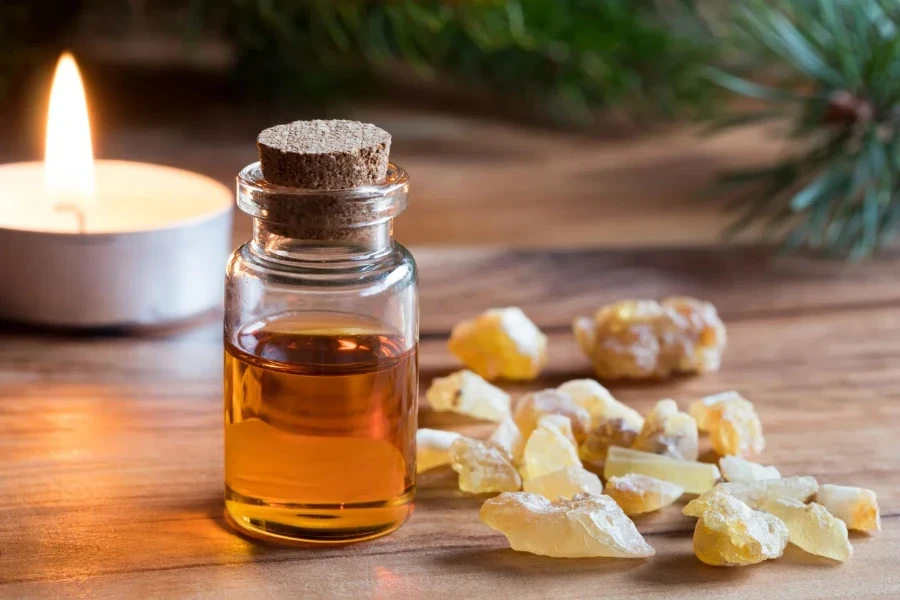Frankincense oil, often referred to as the “king of essential oils,” has been cherished for centuries for its aromatic and therapeutic properties. In 2025, this ancient elixir is experiencing a resurgence, aligning perfectly with the growing trends in wellness and natural beauty. This article delves into the allure and market potential of frankincense oil, highlighting its relevance in today’s beauty and personal care industry.
Table of Contents:
– Exploring the Allure and Market Potential of Frankincense Oil
– Diverse Varieties of Frankincense Oil: Pros, Cons, and Consumer Insights
– Addressing Consumer Pain Points with Frankincense Oil Solutions
– Innovations and New Products in the Frankincense Oil Market
– Key Considerations for Sourcing Premium Frankincense Oil
– Final Thoughts on Navigating the Frankincense Oil Market
Exploring the Allure and Market Potential of Frankincense Oil

Defining Frankincense Oil: A Timeless Elixir
Frankincense oil is derived from the resin of the Boswellia tree, native to regions such as the Middle East and Africa. Known for its rich, woody aroma, this essential oil has been used in religious ceremonies, traditional medicine, and skincare for thousands of years. Its multifaceted applications range from promoting relaxation and reducing stress to enhancing skin health and combating inflammation. The timeless appeal of frankincense oil lies in its versatility and the profound sense of well-being it imparts.
Social Media Buzz: Trending Hashtags and Influencer Endorsements
In the digital age, social media plays a pivotal role in shaping consumer preferences and driving product trends. Frankincense oil has garnered significant attention on platforms like Instagram and TikTok, with hashtags such as #FrankincenseOil, #NaturalBeauty, and #WellnessJourney trending among beauty enthusiasts and wellness advocates. Influencers and celebrities are increasingly endorsing frankincense oil, showcasing its benefits in skincare routines, aromatherapy sessions, and holistic wellness practices. This social media buzz not only amplifies the product’s visibility but also reinforces its credibility and desirability among a broad audience.
Aligning with Broader Trends: Wellness and Natural Beauty Movements
The global shift towards wellness and natural beauty is a key driver of the growing demand for frankincense oil. Consumers are becoming more conscious of the ingredients in their beauty and personal care products, seeking natural and organic alternatives that promote health and sustainability. Frankincense oil, with its natural origins and therapeutic properties, aligns seamlessly with these broader trends. According to recent market insights, the fragrances and perfumes market, which includes essential oils like frankincense, is projected to grow at a CAGR of 7.63%, reaching USD 49.05 billion by 2030. This growth is fueled by the increasing consumer preference for high-quality, natural products that enhance personal well-being and reflect a commitment to environmental responsibility.
In conclusion, frankincense oil stands out as a timeless elixir that resonates with modern wellness and natural beauty movements. Its rich history, coupled with its versatile applications and growing social media presence, positions it as a valuable asset in the beauty and personal care industry. As consumers continue to prioritize health, sustainability, and authenticity, the market potential for frankincense oil is poised for significant growth in the coming years.
Diverse Varieties of Frankincense Oil: Pros, Cons, and Consumer Insights

Boswellia Sacra: The Gold Standard
Boswellia Sacra, often referred to as the gold standard of frankincense oils, is highly prized for its superior quality and therapeutic benefits. This variety is predominantly sourced from Oman, Yemen, and Somalia, regions known for their optimal growing conditions. The oil extracted from Boswellia Sacra is renowned for its potent anti-inflammatory and antimicrobial properties, making it a staple in both traditional and modern medicine. However, its premium quality comes at a higher cost, which can be a significant consideration for bulk buyers. According to a professional report, the demand for high-quality essential oils like Boswellia Sacra has surged, driven by increasing consumer awareness of natural health products.
Boswellia Carterii: A Popular Alternative
Boswellia Carterii is another widely used variety of frankincense oil, often considered a more affordable alternative to Boswellia Sacra. Sourced mainly from Somalia, this oil shares many of the therapeutic properties of its more expensive counterpart, including anti-inflammatory and stress-relief benefits. However, it is essential for buyers to ensure the authenticity and purity of Boswellia Carterii, as the market is rife with adulterated products. A report by a leading market research firm highlights that the popularity of Boswellia Carterii is growing, particularly among manufacturers of aromatherapy and skincare products, due to its cost-effectiveness and versatility.
Blended Frankincense Oils: Versatility and Affordability
Blended frankincense oils, which combine different varieties of frankincense or mix frankincense with other essential oils, offer a versatile and affordable option for buyers. These blends can be tailored to enhance specific properties, such as increased anti-inflammatory effects or improved fragrance profiles. While blended oils are generally more affordable, they may not provide the same level of purity and potency as single-origin oils. Business buyers should carefully evaluate the blend compositions and ensure they meet the required standards for their intended applications. The trend towards blended oils is supported by a report indicating a growing preference for customizable and multifunctional essential oil products in the market.
Addressing Consumer Pain Points with Frankincense Oil Solutions

Quality and Authenticity Concerns
One of the primary concerns for consumers and business buyers alike is the quality and authenticity of frankincense oil. The market is flooded with counterfeit and adulterated products, which can undermine the efficacy and safety of the oil. To address this issue, buyers should seek suppliers who provide detailed product documentation, including certificates of analysis and third-party testing results. According to industry experts, implementing stringent quality control measures and sourcing from reputable suppliers can significantly mitigate the risks associated with counterfeit products.
Price Sensitivity and Value Perception
Price sensitivity is another critical factor influencing purchasing decisions in the frankincense oil market. While high-quality oils like Boswellia Sacra command premium prices, buyers often seek a balance between cost and quality. Educating consumers about the benefits and superior properties of higher-priced oils can enhance their value perception. Additionally, offering bulk purchase discounts and loyalty programs can make premium oils more accessible to price-sensitive buyers. A market analysis report suggests that transparent pricing strategies and value-added services can improve customer satisfaction and loyalty.
Application and Usage Challenges
Consumers often face challenges related to the application and usage of frankincense oil, particularly in terms of dosage and blending with other products. Providing clear usage guidelines and educational resources can help address these challenges. For instance, detailed instructions on dilution ratios, application methods, and potential benefits can empower consumers to use the oil effectively and safely. A professional report emphasizes the importance of consumer education in enhancing the overall user experience and maximizing the therapeutic benefits of frankincense oil.
Innovations and New Products in the Frankincense Oil Market

Enhanced Extraction Techniques for Superior Quality
Innovations in extraction techniques are driving significant advancements in the quality of frankincense oil. Methods such as supercritical CO2 extraction and steam distillation are being refined to enhance the purity and potency of the oil. These advanced techniques not only improve the yield but also preserve the delicate compounds that contribute to the oil’s therapeutic properties. According to a recent industry report, the adoption of cutting-edge extraction technologies is expected to propel the market growth of high-quality frankincense oil.
Infused Frankincense Products: Expanding the Range
The market is witnessing a surge in the development of infused frankincense products, which incorporate the oil into various formulations such as skincare, wellness, and aromatherapy products. These infused products offer consumers the benefits of frankincense oil in convenient and user-friendly formats. For example, bath soaks and salts infused with frankincense oil are gaining popularity for their relaxing and therapeutic effects. A market trend report highlights that the diversification of product offerings is a key strategy for brands to cater to the evolving consumer preferences and expand their market reach.
Eco-Friendly and Sustainable Packaging Solutions
Sustainability is becoming a crucial consideration in the frankincense oil market, with increasing demand for eco-friendly and sustainable packaging solutions. Brands are exploring innovative packaging materials such as biodegradable plastics and recyclable glass to reduce their environmental footprint. Additionally, sustainable sourcing practices, including fair trade and ethical harvesting, are gaining traction among consumers who prioritize environmental and social responsibility. A sustainability report indicates that adopting eco-friendly practices can enhance brand reputation and attract environmentally conscious consumers.
Key Considerations for Sourcing Premium Frankincense Oil

Evaluating Supplier Credibility and Certifications
When sourcing premium frankincense oil, it is essential to evaluate the credibility and certifications of potential suppliers. Reputable suppliers should provide comprehensive documentation, including organic certifications, fair trade certifications, and certificates of analysis. These certifications ensure that the oil meets stringent quality standards and is sourced ethically. According to industry guidelines, conducting thorough supplier audits and verifying their compliance with international standards can help buyers secure high-quality and authentic frankincense oil.
Understanding Regional Differences and Their Impact
The quality and characteristics of frankincense oil can vary significantly based on its geographical origin. Factors such as climate, soil conditions, and harvesting practices influence the composition and therapeutic properties of the oil. For instance, Boswellia Sacra from Oman is known for its superior quality, while Boswellia Carterii from Somalia offers a more affordable alternative. Business buyers should understand these regional differences and select the appropriate variety that aligns with their product requirements and target market. A market research report underscores the importance of regional knowledge in making informed sourcing decisions.
Ensuring Consistent Supply and Quality Control
Maintaining a consistent supply of high-quality frankincense oil is crucial for business buyers, particularly those involved in large-scale production. Establishing long-term partnerships with reliable suppliers and implementing robust quality control measures can ensure a steady supply of premium oil. Regular quality assessments, including sensory evaluations and chemical analyses, can help detect any variations and maintain product consistency. A professional report highlights that proactive supply chain management and quality assurance practices are vital for sustaining product quality and meeting consumer expectations.
Final Thoughts on Navigating the Frankincense Oil Market
Navigating the frankincense oil market requires a comprehensive understanding of the diverse varieties, consumer pain points, and emerging trends. By prioritizing quality, authenticity, and sustainability, business buyers can effectively address market challenges and capitalize on growth opportunities. Embracing innovations in extraction techniques and product formulations, along with strategic sourcing and quality control practices, can position brands for success in this dynamic and evolving market.




